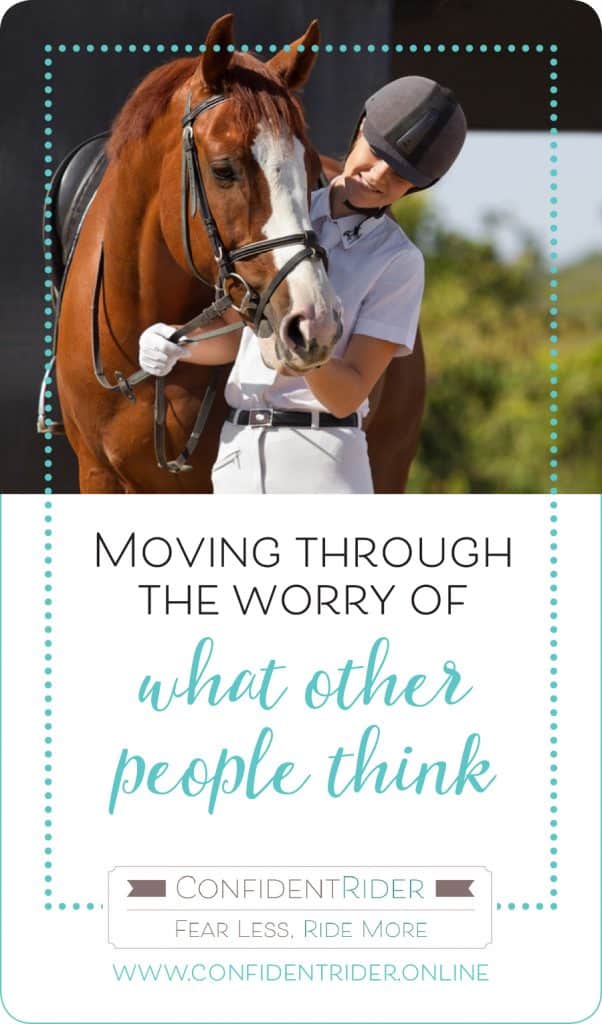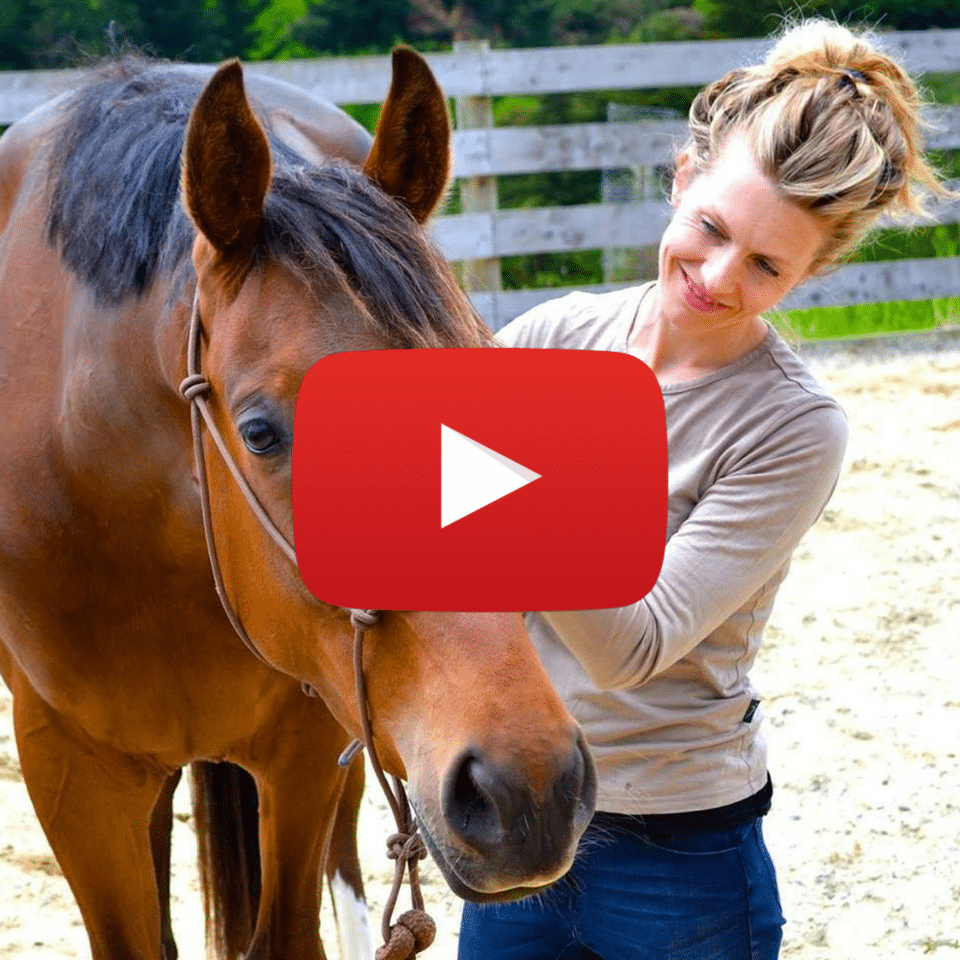Category: Competition
Gaining the Mental Edge
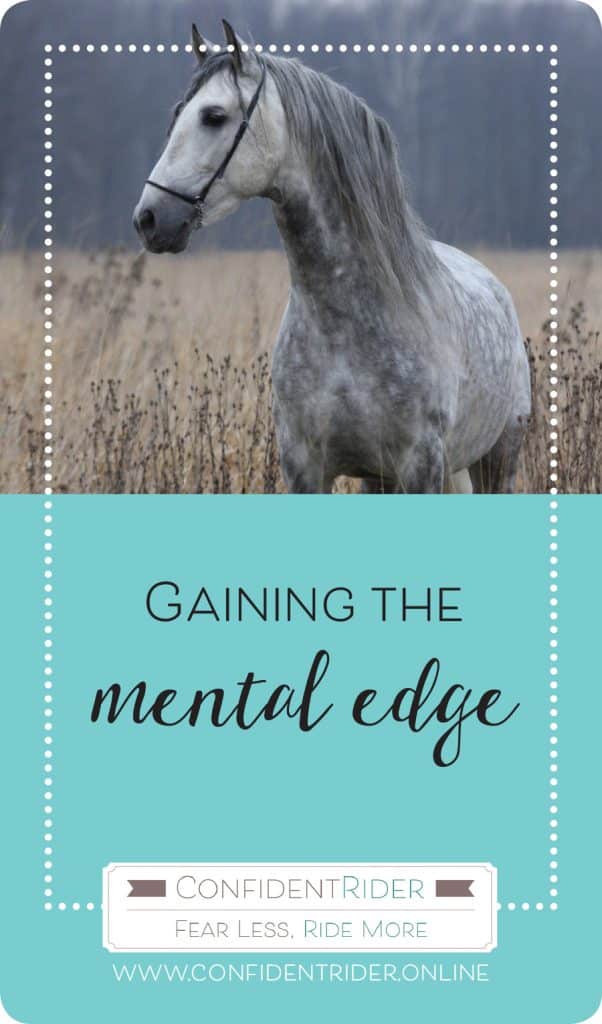
In last week’s blog, I mentioned a five-step process that I work to when training equestrian athletes for competition. The first of these involves developing your “Competition Mindset”, something that is often overlooked when designing and implementing a plan both in the lead up to and on the day of competition.
Creating and optimizing your competitive mindset is so much more than having a “good attitude”. It’s about creating an internal world that fortifies you against outside pressure and distraction and allows you to ride to the best of your ability on any given day. Essentially, it allows you to harness everything that is within your control and leave the rest.
Many studies have shown that if you take a group of athletes with the same level of ability and give only half of them mental skills training, those who received the training will consistently outperform those who haven’t. This proves to us that being able to create the results and outcomes that we want is not just about “working hard”. Time in the saddle is obviously an essential criterion, but making sure you are in the right headspace to really make things happen is crucial.
Creating your competition mindset involves creating an internal space where you can go to mentally prepare yourself and gain the mental edge; it’s about aligning all the components of your inner world- your beliefs systems, your self talk and self-identity- and seeing how they all contribute to creating your external reality.
The foundation stone of your mindset is your belief systems. What a rider believes, what he thinks is possible or impossible to a great extent does actually determine the outcome.
Why is this so? From a biochemical and neurological perspective, when you don’t believe in something, you are sending your nervous system consistent messages that limit or eliminate your ability to produce a result. It’s the glass ceiling effect- you have essentially create a boundary or limitation of what it is the you believe to be possible for yourself, and as a consequence, your mind accepts the limitations and no longer searches for ways break through those boundaries.
When we repeat or reinforce a belief consistently, we give them a sense of permanence that breeds breeds pessimism, procrastination and inaction. Think of yourself when you are in this state. Are you likely to take the necessary action to move you closer towards the situation that you want? When you are feeling pessimistic or like you “don’t have what it takes” are you more likely to look for “ways out” that stop you achieving your goals, or do you create the types of emotional state that will keep you moving forward in times of adversity?
The key to producing the kind of results that you desire is to represent things to yourself in such a way that puts you in such a resourceful state that you are empowered to take the types of quality actions that will create your desired outcomes.
How are your beliefs affecting your outcomes? Do you feel as though your competition mindset could do with a bit of a polish?
xx Jan
Dealing with “brain freeze” in the ring
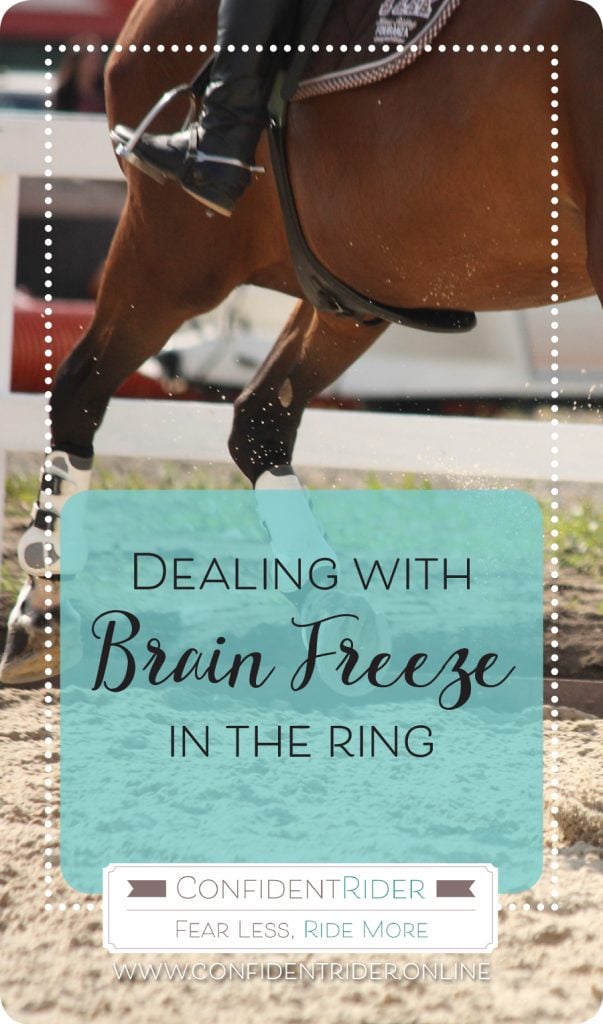
Jessie asks:
I’m wondering why I can warm up for Show Jumping with no stress but get me in the ring and jumping a round and everything I know freezes and my brain shuts down! This happens particularly with heights of jumps I’m not yet truly comfortable with. I feel reasonably comfortable now with 1.05m, but
1.10m and above, I doubt my ability to meet the jumps at right stride. It is fine at home but when out competing the pressure comes on. What can I do about this?
Hi Jessie, thanks so much for your question! Interestingly, I was having a conversation around this particular topic tonight, and I was talking about how my approach has changed over the years from trying to apply solutions “in the moment” to looking to work with systems and plans that actually give you mental strength and allow you to deal with any outside pressures and distractions that may come up at any given moment.
There are two parts to it that I want to break up individually. The first and most obvious thing that springs to mind in relation to your question is the shift in focus that you will be experiencing in the warm-up compared to when you are out there in the ring actually competing, and this in turn affects your processes. Let me explain what I mean.
When you are warming up, you are primarily engaged in a training situation. Your focus may be on making sure that you are holding form over the jump, or that your striding is correct, that you have your horse in front of your leg; all of the processes and actions that you need to take care of to ensure that you and your horse are jumping to the best of your ability. If you make a mistake, then what most likely happens is you repeat the exercise and you look to correct it. In other words, everything that you focusing on is very much action based and within the realm of what you can control and what you can influence. You are dealing with what is directly in front of you and you aren’t getting too far ahead of yourself.
What commonly happens when you enter the ring, however, is your focus shifts; it moves from how do “I take this jump this in this particular moment” to “I want to get a clear round” or “I am looking to create “x” result”; obviously we may not be thinking precisely those words but in essence, our focus shifts from a very practical, process based platform, to a results and outcome based one. In doing so, we are directing our focus towards that which is outside of our control; obtaining a specific result or even getting a clear round is not something we can necessary control. Feeling the burn, our brain responds to the pressure in an unfavorable manner for the task at hand; on a physiological level, our body becomes adrenalized and consequently the part of our mind responsible for measured and rational thought is ignored in favor of the very primal parts that are revving up to get us out of the situation as quickly as possible. The need to have a good handle on your arousal state- your body and breath control- becomes really important at this point so you can maintain your heart and respiratory rate to a range that allows you to think clearly and easily.
On the flipside, what we CAN control are the specific actions or things that we need to pay attention to in order to maximize our chances of producing the result that we want- just as we were in the warm-up ring.
Secondly, you have highlighted that these feelings are particularly strong when it comes to dealing with heights that you aren’t totally comfortable with, which makes perfect sense. This is where we need to strategy, on the one hand to get you to a level where you feel confident jumping the heights you are referring to (so dealing directly with competency, skill level and time in the saddle at those heights) and then managing your emotional framework so that your self-talk, your focus and the way you are holding and using your body supports a confident mindset. The first is time dependent, but the second is able to be cultivated instantaneously provided you have the tools and are able to make an ongoing decision to constantly redirect your focus to the most empowering context.
I referred to the need to also create mental strength; to me this is the only way to deal with the ongoing pressure of competition, especially as you begin to move up the grades. Practices like focusing on what it is that you want as opposed to what it is that you are trying to avoid, ensuring your self-talk is positive and supportive, and reading or watching books or videos that motivate and inspire you on a daily basis all allow us to update our mental software and fortify us against outside pressures and distractions.
Thanks again for your question, I hope that helps!
xx Jane
Managing Your State in Competition
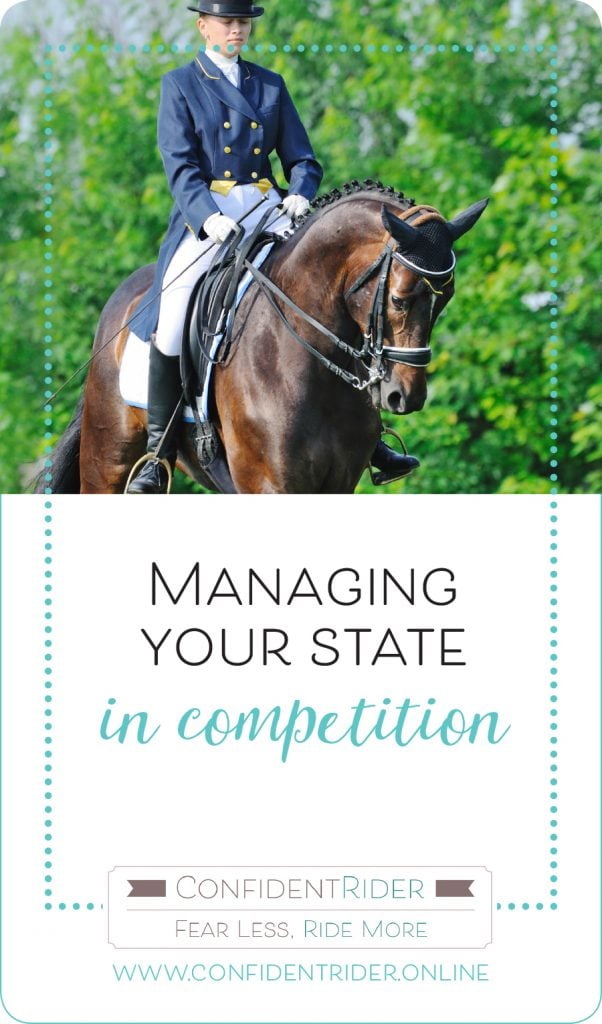
When it comes to competing, or performing in high-pressure situations, being able to manage your emotional state is critical. In sport, the arousal state refers to the ability to manage your heart rate within a certain range- a range that ensures that we are performing both mentally and physically at our best. Obviously, the variability of this range changes depending on the sport in question, but what we do know is that we are always looking to keep our heart rate below 120 beats per minute.
I understand if this all seems a little specific (and possibly even a little boring if you aren’t into the nitty gritty of it all #geekalert) but whilst we may not be able to measure in the moment exactly what our heart rate is (or even want to for that matter), what we can all almost certainly appreciate is the result. Leaving our optimal zone has consequences on our brain function which yields some common signs and symptoms; loss of focus, clarity and the ability to make clear and rational decision to name a few! Not ideal when we are out there in the ring!
Whilst few of us are gifted with the kind of control that allows us to control our heart rate, what we do have control over is our breath. Your ability to control and regulate your breath then becomes your super power in exerting control over both your heart rate (the respiratory and cardiovascular system are intimately connected) as well as brain wave activity. It’s the most tangible tool that we have to manage our physiology and our emotions to ensure that we are in the optimal zone for training and competing.
One of my favourite breath techniques fit for purpose is the 1:2 breath ratio. It’s very simple to practice. Breathing to this ratio mean that if you means that if you have an inhalation of 4 counts, you want your exhalation to be 8 counts. If you have an inhalation of 6 counts, you want your exhalation to be 12 counts. You are doubling the length of your exhalation comparative to your inhalation.
This is a really easy, invisible and highly effective tool that you can use at any stage. You could use it when you are waiting for your turn in the competition arena, you could use it if you feel like you are getting a little disheveled and off centre in training; at any point that you feel as though your thought processes are getting a little “out of hand” in relationship with what you would like them to be, bring in this 1:2 count breath ratio and I guarantee you that you will start to turn things around.
xx Jane
Creating The Future In Advance
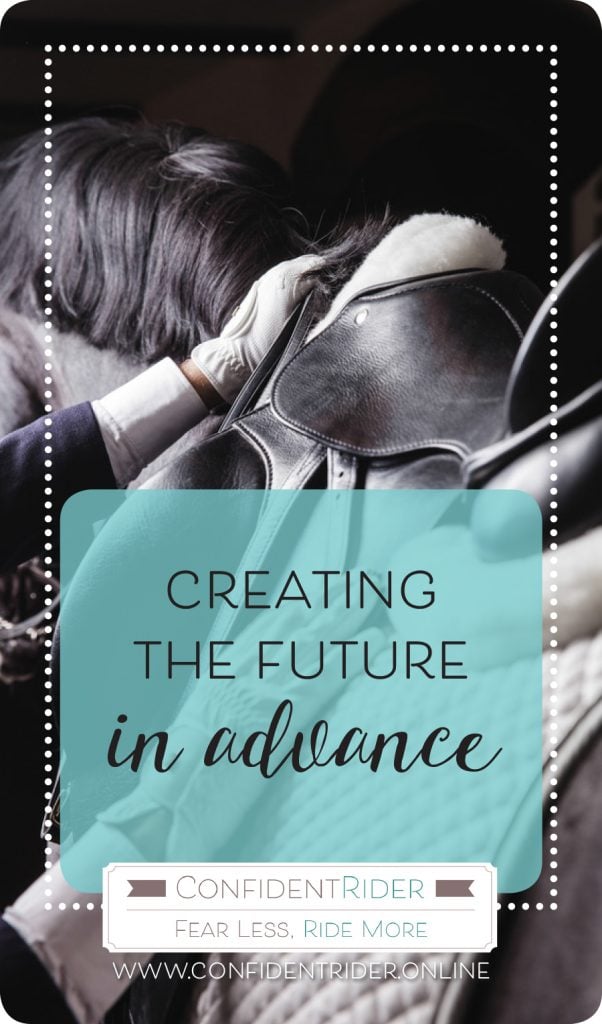
When I started writing this blog yesterday, I was being all very adult about it. I wrote down some stats about the positive effects that visualisation has shown to have in a variety of scientific studies exploring athletic performance, and put forward some compelling arguments as to why you should include as a visualisation practice as a non-negotiable part of your “training workout”. I presented a pretty tight case if I do say so myself.
The thing is, when I read it back, it all seemed a little bit… dry. Boring even. And so I gave myself a stern talking to and deleted the whole lot. You know why? Because visualisation is so far from boring. It’s the polar opposite of boring. It’s like lets-bust-out-an-improvisational dance exciting.
Visualisation is, in fact, your creative super power. It’s useful (nigh on essential) for not only creating our most dreamed about future outcomes but for releasing the shackles of negative or substandard performances that we may have experienced in the past. That’s why when it comes to creating a mental fitness plan for both myself and for other rider, it’s an essential tier that I never, ever overlook. Visualisation, or imagineering is the process of creating the future in advance and showing our minds how it is that we want things to go. And I certainly didn’t want the gods of visualisation to release a thunder clap on my head for presenting it any other way.
Visualisation is your most powerful ally, and the reason for this is that is has a direct affect on the subconscious mind. Whilst on a conscious level we are able to discern between the real and the illusory, your subconscious mind is unable to make this distinction. Quite simply, it cannot tell the difference between something that has occurred in ‘real life’ and something that is vividly imagined.
Creating or envisaging a scene or movie in your mind, with great clarity and detail, creates a magnetic pull; it quite literally reorganizes your mental software. If you imagine or visualize something often enough and with enough feeling and detail, your subconscious mind comes to accept it as a given- it becomes so familiar to you that both psychologically and physiologically you feel as though this is the norm for you, that you have been in this position, living out this scene as you see it in your minds eye many times before. Then the decisions that you make, the actions that you take all work together to set you in alignment with this subconscious target, with this image that you have imprinted on your brain. It’s essential to creating a targeted and specified training routine to optimize your emotional and physical state for competition.
If you are on the fence about its efficacy, think of it this way. If you are faced with a challenge that you know you have the skillset or the competency to deal with effectively, and yet still feel unable to do so, the only barrier that exists that impedes your ability to follow through is in your head. The place to deal with it then is in your head also. Everyone situation that we think about we create a mental movie for, whether we are aware of it or not. Creative visualisation is simply harnessing the power that we are utilizing unconsciously in every moment and using it to our advantage.
See things as you want them to be. Focus on the outcomes you want to create.
Over and out!
xx Jane
Making It Count When It Counts
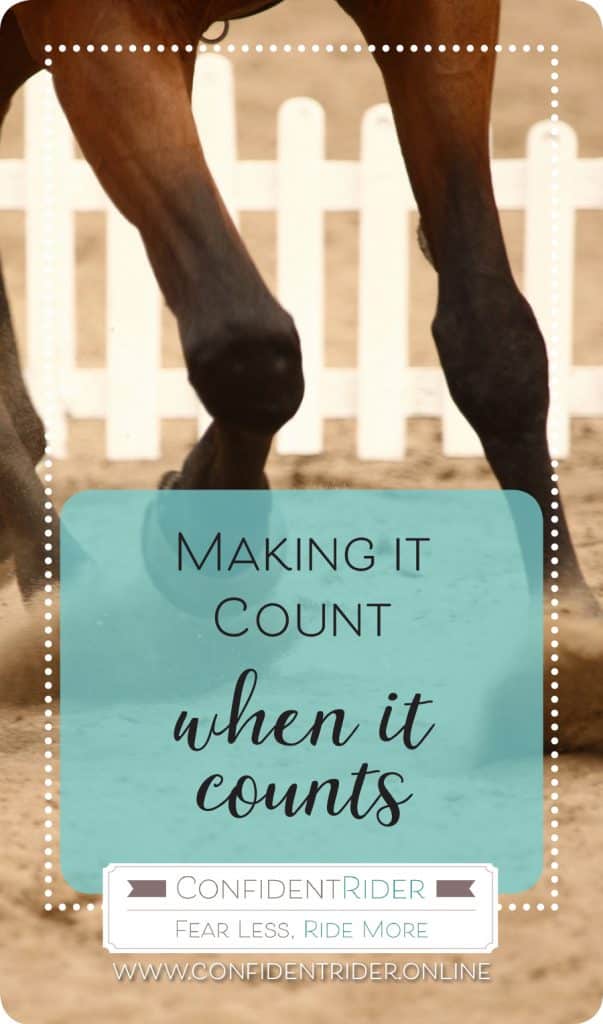
It’s funny how you can really, really love something that makes you feel at the same time like you might actually be sick. I think there are very few things in the world where I could safely pair those two qualities together with confidence. Love and an intense feeling of nausea. But when it came to riding in competition that is most definitely how I used to feel. I loved it, but the enjoyment was always something that came later, once the plaits had been taken out and my horse was peacefully munching his hay by the side of the truck. It was then, when I finally took a breath out, peeled off my jacket and plucked out the two million bobby pins that were required to keep my mountain of hair in some form of control under my helmet that I allowed myself to unravel. This usually happened at the same time as I was eating some sort of toxic looking sausage from the nearest food van, but details details. Enjoyment at competitions for me was like a mist; it was all around me but I couldn’t never quite grab hold of it.
It’s not that I didn’t experience success, or that I felt like I didn’t have what it took to make it happen. I did. I really did. I believed in my horse, I worked hard, put in the training, got the lessons. There was really no viable reason for me to feel so nervous- but that didn’t stop the fact that I did.
As I competed from an early age, I had a lot of time to think about this. And to notice the effect, not only on my enjoyment, but also on my ability to ride the way that I knew I was capable of. How could it be, I asked myself, that I could ride a test in the morning and a similar test on the same horse in the afternoon and experience a completely different result? What had changed (aside from the fact that I have possibly eaten another sausage) between those two periods? It most certainly wasn’t my skill level. And it wasn’t the ability of my horse. It finally dawned on me that the only thing that had changed from the test that I rode at 9.30 am and the test that I rode at 3 pm was my mindset.
Do a little experiment with yourself now. Think back to a time in your riding or in your competitive life where you were really on the money; a time when you were out there, wishing it was the Olympic qualifier you are so dang hot right now. Got that? Awesome.
Ok, now sorry to do this to you, but I want you to have a quick think about a time when things were perhaps not so hot. Perhaps you were feeling like nothing was going to plan, like your left leg may actually be detached from the central functioning unit of your brain because it was basically doing its own thing and as you rode down the centre line, or jumped the jump or rode the pattern, it was like you were doing so blindfolded, with something in your ear. I might have got a bit enthusiastic there but you get the picture.
These experiences can happen days or even hours apart, within spaces of time where the difference in the result that you are able to produce has nothing to do with your level of competency or your skill set as a rider and has everything to do with the mental and emotional framework that you are operating from. Your skill level hasn’t changed, it’s just that the outcome of that particular ride is compromised because your reactions will be dictated in the wrong emotional language for what is required; things will act and behave differently coming out of you and as a result, everything changes. You are not in a state where you were able to access the answers and produce the results that are required for the environment you were riding in.
Once I understood this- like really understood this- it was like hitting the jackpot. I knew that as long as I continued to put the hard yards in physically, if I continued to ignore the fact that my mental fitness was in fact the biggest impediment to my success, I was never going to get very far. In fact, I was going to be going round in circles.
The fact is if you are experiencing results that don’t reflect what you know yourself to be capable of- and it might even be that they are really good results but you know you can do better- then what needs to change is your mind. You need to take your mental training as seriously as you do your physical training.
Building the muscles of your mind works in precisely the same way you build the muscles of your body; with use and with practice. You wouldn’t rock up to compete at a 10km running race having only ever gone for a quick jog the night before. Or if you did, you would know your chances of producing a stellar result would be compromised. Yet this is the exact thing many of us do time and time again at competition. We know we feel a certain way competing. We experience it time and time again, and yet we continue to just hope things will magically get better. It’s bonkers.
In order to create a change in your experience, the first thing that has to change is you. Investing in your mental strength and developing focus, fortitude and mental power will infinitely accelerate your progress and ensure that you can consistently produce the results you are capable of. You will be in control of your state, and as a result, you can ask the right questions of yourself under pressure to produce the answers that you want on the day.
The beauty is the confidence, optimism, focus, fortitude- these are all skills, skills that can be easily learned with a little bit of dedication and practice. And the learning always starts with the decision to no longer tolerate the challenges that you are experiencing that you know are holding you back. In their place, we are then free to embrace new behaviors and rituals that will allow us to continually manage our mental and emotional framework and as a consequence showcase the skills of both our horses and ourselves when it matters to us most.
xx Jane
Lacking Motivation to Ride

Alex says:
I have no motivation! I still want to ride and think to myself every day “I am going to ride today and we are going to work on something specific”, and then when it comes down to it, my attitude changes to, “maybe tomorrow… it looks like it might rain… I have a headache coming on…” So many excuses! Is there anything I can do?
Hi Alex,
Thank you so much for your question. I know that a lack of consistent motivation is something that many riders struggle with. The reasons behind why this is the case is usually individually specific, and can also trace back to past experiences or negative beliefs and associations.
In this blog, however, I am going to keep it really practical and outline a few “likely culprits” for you in the hope that you will identify with one or a few of them and be able to create a much more inspired path forward!
1. Reconnect with your purpose
Lack of motivation can arise when we become disconnected from our purpose, when we have lost sight of why we are doing what we are doing in the first place. When we are divorced from our “why”, it is much harder to create the “what”, and we need both in order to create an effective, solid and uplifting strategy for the future.
Start first with your why; why do you ride? Why do you have horses? Why is it that you do what you do?
Reconnecting with why you ride in the first place will also give you something tangible to compare your current riding experiences against. For example, if you ride for the pure joy of it, but at the moment you aren’t having much fun at all, you are denying one of the basic values that motivated you to ride in the first place. If this is the case, all is not lost; quite the opposite! Instead, you now know what you need to adjust and alter in order to ensure that those core values or intrinsic drivers are present in your riding activities and relationships.
2. Keep it simple
In order to create momentum and ensure that you are aren’t feeling discouraged or overwhelmed at the thought of riding before you even get there, I would work to ensure that you have a really clear outcome for your ride that was achievable for you and your horse. You can stretch yourself if you feel the need, but for the moment concentrate of creating markers for yourself that are tangible and achievable targets. Essentially, set yourself up for success! The more “good” rides you have, the better you are going to feel about your riding experiences and capabilities. I’m not suggesting that you don’t aim higher in the future, but for the moment make your aim to create momentum; having enjoyable rides with successful outcomes is the best way to make that happen!
3. Have a talk to your future self
Usually, when we make a decision and create a strategy for the future of our riding, we do so from a very reasoned and intelligent position. We have looked at the facts, understand what is needed and are committed to following through with what is required. If we find, however, that the moment we step outside are are failing to put that plan in action, then we are allowing our current mood to override what it is that we ultimately want, and it is in this moment, in this moment of decision that our greatest power lies.
If you go outside to ride and you find you are talking yourself out of it, assess whether this is something that your future self if going to want and be proud of. We have made a decision to get out there and ride based on our dreams and aspirations, and we have an idea of what we want our future selves to look like or be capable of.
If in the moment you decide, uggh, I know, I know I should ride my horse but I really don’t feel like it, take stock of the moment and think intelligently. Think about what it was in the past that led you to decide that you need to ride in this moment and what that is going to create for you. Connect to something bigger than the present moment. Refuse to allow your mood to cast the ruling vote in a situation that ultimately you know you are going to regret later.
4. Make yourself accountable
Create a situation where you make a commitment to someone outside of yourself, and then arrange to report back to them once you have followed through. In many instances, it becomes easy for us to become a bit faffy because there is not immediate consequence to our actions; so no one will really see whether we ride or not, and maybe we even keep it to ourselves just in case we don’t actually ride when we say we will. Enough of that! It’s not about becoming militaristic, but it is about setting an intention and then developing the consistency of action that allows us to follow through. Tell someone your plans and then let them know once you’ve done it!
Let me know how you get on!
xx Jane
The Magic of Focus
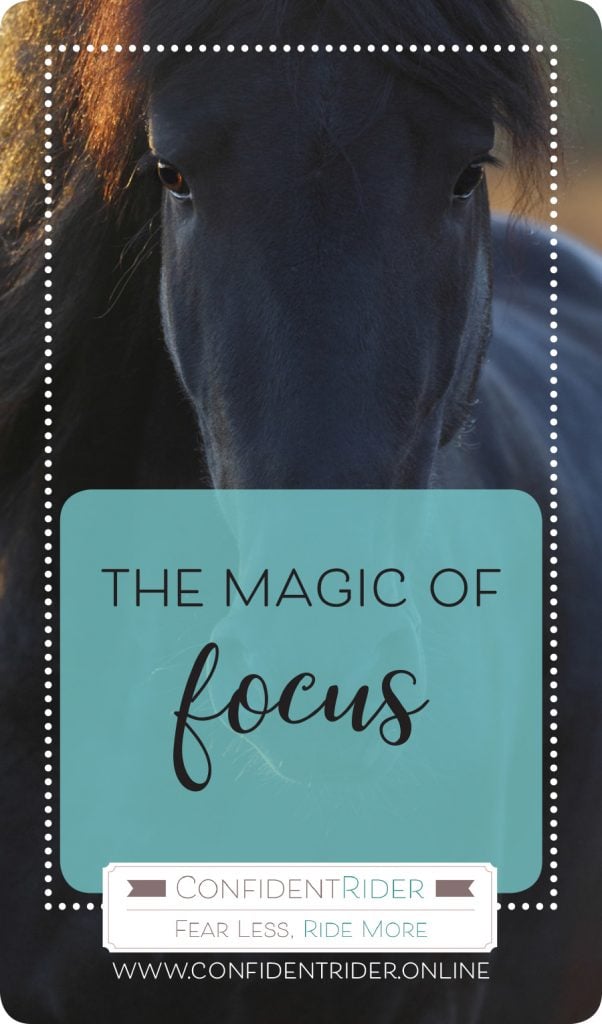
Your focus determines your reality.
It might sound simplistic, but it’s true. The basis of it is this: whatever you choose to focus on you give meaning too, and as soon as you assign meaning you assign power. Experience only becomes positive or negative once you assign meaning, and the meaning that you assign is a direct result of your focus. Meaning either lifts you up and drives you forward, or brings you down.
The real skill then, lies in your ability to continually control and direct your focus and to put every situation and event into an empowering context.
Let’s get down to the nitty gritty. If you are choosing on a regular basis to focus on what isn’t working in your riding or your life, then more of what isn’t working is going to appear. Why? One of the universal habits that we have as human beings is that we are creatures of deletion. Our unconscious mind is capable of processing so much information from our environment (it’s something crazy like 3 million pieces of information per second), that it would quite simple send us loopy if it all filtered through to our conscious awareness (which conversely can only manage 6 or 7).
As a consequence, we pick out only a handful of things to bring to the forefront of our minds, and what we pick out is based on two primary components; our focus and our underlying belief systems about who we are and what we are capable of. If we choose to direct our focus on all the areas of our riding where we feel lack, displeasure or discomfort, then all of the existing forces that would ordinarily naturally oppose this- ie the areas where things ARE working- seem to magically disappear. That don’t support the framework that we are choosing to operate under and as a result we delete them from our conscious awareness altogether.
That’s the power of focus.
Let’s talk about some ways that you can apply the Super Power that is Focus to your benefit and not to your demise!
1. Focus on what it is that you want
Most riders that I work with are exceptionally gifted at articulating what it is that they don’t want and not so good at clarifying what it actually is that they do want. As a rule of thumb, think of constantly directing yourself towards that which you are looking to create or manifest, rather than moving away from something that you are wanting to avoid.
For example, if I was to ask you what it is that you are wanting from your horse at the upcoming competition, and your answer was that you didn’t want him to be tense or anxious, you have already formed a negative focus. What you are actually wanting is for him to be calm and relaxed. How you choose to phrase what you desire will determine your focus as well as the associated images that play over in your mind when you think about the event.
Move towards something rather than away. Focus on what it is you want.
2. Focus on what’s happening right now
If you want to harness a super power, harness the power of being in the moment. If you focus is too much in the past, or projecting into the future, you can’t be offering forward the best version of yourself in the current moment.
Set your goals and work towards them with determination and dedication, but as soon as your bum hits the saddle, deal with what’s in front of you. Be the rider that your horse requires you to be from moment to moment, and focus on responding to their needs with leadership and compassion.
You can’t be two places at once. You can’t be here and there at the same time.
Always focus on the next right move for you and your horse.
3. Train yourself to focus on the positive
This doesn’t mean becoming Mary Poppins (although, frankly, she had a lot of good things to say!). Positivity is not a fixed state, but rather continuous positive action. It’s the ability to draw on the resourcefulness that you have inside of you and the means to continually ask yourself empowering questions.
What do I need to do in this moment to move forward in the best manner possible?
How do I need to behave in this situation?
What resources can I draw on that will help me progress from where I am now to where I want to be?
Positivity. Self-belief married with consistent positive action.
Getting in The Zone for Competition
[et_pb_section bb_built=”1″ admin_label=”section”][et_pb_row][et_pb_column type=”1_2″][et_pb_image _builder_version=”3.0.71″ src=”https://confidentrider.online/wp-content/uploads/2017/03/JoyRide-Pinterest-Pins-24.jpg” show_in_lightbox=”off” url_new_window=”off” use_overlay=”off” sticky=”off” align=”left” always_center_on_mobile=”on” border_style=”solid” force_fullwidth=”off” /][/et_pb_column][et_pb_column type=”1_2″][et_pb_text _builder_version=”3.0.71″ background_layout=”light” text_orientation=”left” text_font_size=”19″ text_line_height=”1.8em” border_style=”solid”]
I went to a competition last weekend, and it takes me a good 20 minutes or so before I really get it together. I get completely thrown off course by everything around me- people warming up, looking at other coaches and riders on the sidelines watching me ride. How can get my head in the right space so I can produce the results in competition that I am experiencing at home?
[/et_pb_text][/et_pb_column][/et_pb_row][et_pb_row admin_label=”row” background_position=”top_left” background_repeat=”repeat” background_size=”initial”][et_pb_column type=”4_4″][et_pb_text background_layout=”light” text_orientation=”left” text_font_size=”19″ text_line_height=”1.8em” border_style=”solid” background_position=”top_left” background_repeat=”repeat” background_size=”initial” _builder_version=”3.0.71″]
Start by thinking of every emotion that we experience as a form of energy. Getting in the zone, or getting our head in the right space, involves concentrating all of the energy that is available to us at that particular moment and directing it towards our ultimate outcome. When we do so effectively, it gifts us with the ability to ride with focus and clarity and the means to continue to make effective decisions in the face of outside pressure.
Everything that you have going on inside your head has everything to do with how well you end up performing.
When you arrive at a competition, the emotions, pressures and distractions of your environment becomes interspersed with what it is that is going on inside your head. We begin to mix the energy of the outside with the energy of the inside, and the potential result of those two forces combining can form any number of possible results. Depending on your mental skill base, what manifests on the outside could be feelings of nervousness, anxiety and loss of focus- or it could be confidence and clarity. It all comes down to the ability to consistently direct your focus in a way that empowers you and have the mental strength and skills that will enable you to harness the energy and use it to your advantage.
This is what riders and athletes who perform at the highest level know how to do. They recognize the forces that will be outside of their control and influence but have developed the mental fortitude that allows them to continue to perform at their optimum in the face of it. Across the board, it is those riders who learn and practice mental training techniques along with the physical training techniques that are consistently able to produce the highest level of results.
So how is this possible? How do you develop that kind of mental strength for yourself? With my private clients, I work to a 5 step program that embodies the following elements:
1. Developing your competition mindset. This encompasses several elements that involves analysing your underlying belief systems, self talk and aspects of self identity which feed in to your ability to create the results you desire.
2. Breath work that ensures you can effectively manage your emotional and physical responses to stay in the optimal arousal zone.
3. Visualisation techniques
4. Effective pre and post competition strategy, as well as a plan for competition day
5. Anchoring and mental programming techniques.
Just as you would visit the gym or hire a personal trainer to create optimal physical fitness, creating the type of mental strength that we need to deal effectively with competition pressure requires some training and pre-planning. You get out what you put in. Expecting to ride and perform at your optimum without training your mental muscles means that you launching off an unstable foundation; sometimes it will work out, sometimes it won’t.
The key lies with developing an effective mental training plan that will allow you to simultaneously stay positive, resourceful and focused whilst deflecting outside pressures that could potentially detract for your overall purpose and outcome.
xx Jane
[/et_pb_text][/et_pb_column][/et_pb_row][/et_pb_section]
Rider Q&A: How much success can you handle?

Q: Hi Jane, I feel like I have plateaued competitively. I just can’t seem to crack it. It’s an always a bridesmaid, never the bride situation! How do I break through to that next stage? I feel like I’m permanently stuck in second place!
Many of us are more than aware of what it is that we fear, but not nearly as many are aware that we also have limits on how much success we can handle. A exercise I get all of my riders to go through is to ask themselves, how much success can you handle? How much is too much? It’s so enlightening what comes up!
The level of “comfortable success” that we have defined for ourselves creates a self-built glass ceiling. This upper limit is predominantly a consequence of our unconscious belief systems that seek to keep us within a limit that is known to us and that we feel that we can comfortably handle. The key word here is “unconscious”; if left unexamined, our habits and behaviors keep looping back around in a continuous circuit, and we are unable to make the kinds of decisions, and consequently take the kinds of actions that can propel us to the next stage.
If you find this confusing, think of it this way. Your belief systems inform the decisions that you make in any given moment, and your decisions inform your actions. Your actions then create your results. If you have a belief system that seeks to hold you within a certain limit (again, this is usually not a conscious decision), then you wil make poor decision, which leads to poor results and the cycle is reinforced.
The process involved to breaking it is to discover the height of that glass ceiling and then to develop a vision that goes beyond it; because we are talking about this is the context of the competitive arena let’s use that as an example. Please note I am working on the assumed knowledge that both you and your horse have the skills and competency to ride at the “next level”; what I am addressing here is your mindset.
If you feel like you have plateaued at a certain point, or you are always getting the same outcomes competitively, a really useful exercise is to sit down and to think for yourself about the level of success that you are comfortable with. Start right at ground zero, right at grass roots. It might be that going to a casual open day is something that you are really comfortable with and then you can step it up and go right, Well an A&P Show competitively; I am comfortable with what outcome at an A&P Show?
What do I think is possible for myself, and what outcome do I think, oh yeah that is okay!
Now, we are going to leap up to Horse of the Year, and say right, if I am at a big National Event, how do I feel about being there? If you start to think about well I really shouldn’t be there, I mean that is way beyond what I am capable of! Then you know that you have gone outside of your comfort zone and just below that is that glass ceiling, or that threshold that you are comfortable with.
Whatever you are comfortable with, whatever your threshold is, the process is the same. Once you have identified that level then I want you to step beyond it and ask yourself, well what would be the next step up from here?
What situation, what environment does that encompass? What does that require that I do with my horse? Then I really want you to create your vision as a result of that. To associate yourself as much as possible in that picture and get comfortable with being there.
In order to create that form, in order to actualize that level of success as a part of your reality you need to be comfortable with that as a mindset, as a thought form, as a thought process. Creating your vision is part of that familiarization and part of that comforting process that I really encourage you to get into and is so, so important.
Best of luck!
xx Jane
Rider Q&A: Dealing with nerves in the warm up ring
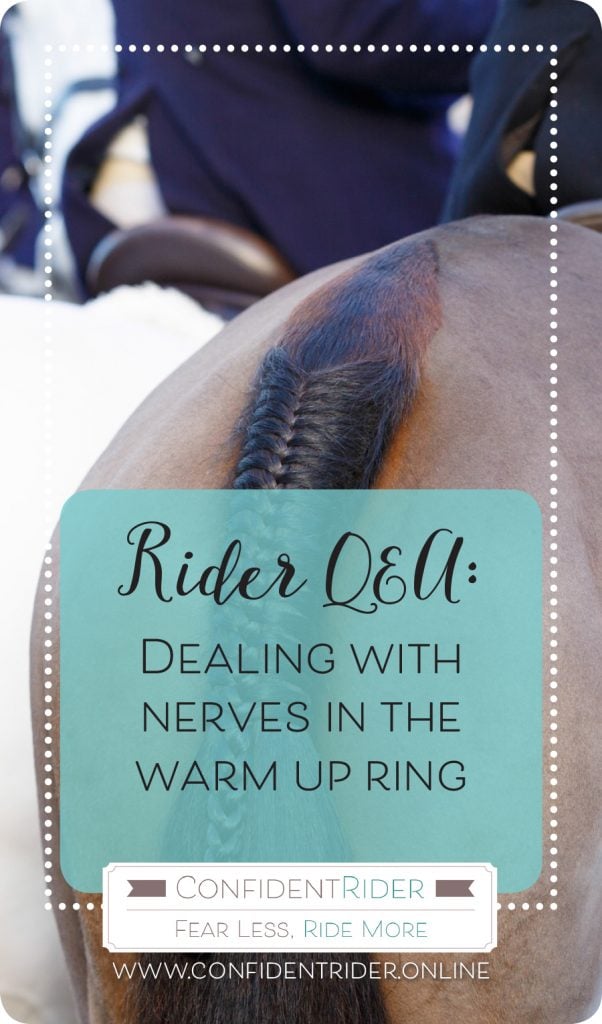
QUESTION: Hi Jane, I find warming up in a busy area (particularly showjumping) quite off putting! Any ideas on how to calm nerves as obviously it’s a situation that I cannot avoid or change!
The beauty of competition and the situation that you are describing is that you know that it is coming, and as a result, you can plan for it in advance. There are two strands that I would pay attention to in this instance; the first is how to create a mental fitness plan that will fortify you against the pressures and distractions created by the competition environment. The second is developing awareness and understanding of the breath so you can consciously work with it to effectively manage nerves and anxiety.
Managing the warm up ring is obviously not something that is within our control; the only thing thatis within our control is what is going on inside our heads. When we immerse ourselves in a competitive environment, the emotions, pressures and distractions of everything around us becomes interspersed with what is going on inside our minds. When these two forces combine, any number of potential scenarios can result. Depending on our mental skills base, what manifests on the outside would be anxiety, fear, or loss of focus- or it could be confidence and clarity. It all comes down to the ability to consistently direct your focus in a way that empowers you and have the mental strength and skills that will enable you to harness the energy and use it to your advantage.
In order to do this, we need to develop a mental training plan that builds the muscles of our mind in the same way that we pay attention to our physical preparation. Just as you would visit the gym, or hire a personal trainer to create optimal physical fitness, creating the type of mental strength we need to deal effectively with competition requires some pre-training and pre-planning. You get out what you put in. Expecting to ride and perform at your optimum without training your mental muscles means that you are launching off an unstable foundation; sometimes it will work and sometimes it won’t.
Secondly, working with and consciously controlling your breath will yield instantaneous results if you are dealing with an acute bout of nerves! Whenever we are experiencing a stress response, we are in what is known as sympathetic dominance- our nervous system flicks into fight or flight mode and we experienced an array of physical and mental symptoms as a result (a nervous tummy, dry mouth, sweaty palms to name a few!). The inhalation portion of the breath is linked to our sympathetic nervous system, whilst the exhalation is linked to the parasympathetic nervous system. Consequently, we want to work with a breath that allows us to move into parasympathetic arousal- meaning we need to focus primarily on the exhalation.
The 1:2 breath ratio is one of my favourite techniques that I share with riders. In practical terms this means that if you have an inhalation of 4 counts, you want your exhalation to be 8 counts. If you have an inhalation of 6 counts, your exhalation will be 12 counts. You are doubling the length of your inhalation comparative to your exhalation. You can use this breath technique as part of a pre-warm up ritual, or as a means to redirect your focus and calm your nerves in the warm up ring.
Good luck!
xx Jane
How to change your thinking so you come out winning!
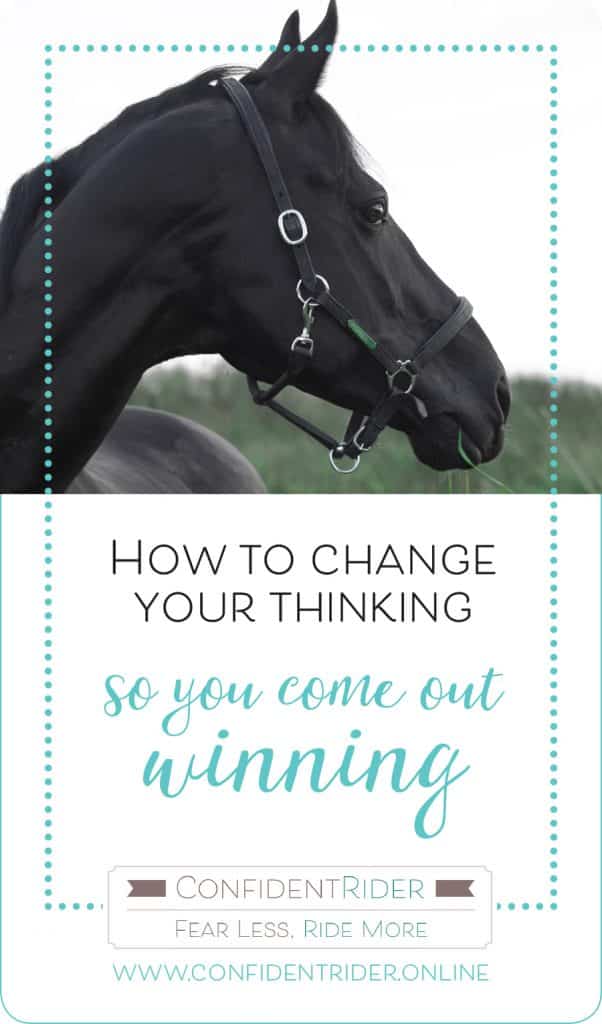
A curly question that I get asked a lot is what do successful riders have that others don’t? What is it about them that allows them to change their thinking on a less than average day and come out on top?
First up, we need to get our head around what the notion of success actually is. Success itself is a very subjective term and can only be defined on an individual basis; as a consequence, lets move forward on the understanding that success is the ability to move towards or create a desired result, regardless of what that result may actually be.
To me, successful riders are not those who have a special gift, or a secret skill that separates them from others. Instead, they have mastered a very specific but most excellent skill to have and that is the ability to control their emotional state.
State is a combination of your psychological and physiological condition and something that we manifest as an outward representation of our internal world. For example, if you are currently feeling nervous, then you are in a nervous state. The same can be said for confidence; when you are feeling supremely confident, you are in a confident state.
How we respond or behave at any moment in time in based on the state of our mind and body. So with this knowledge, how do we then go about managing our state so that we can consistently move towards our desired outcome? It boils down to two things; the ability to consciously direct our focus, and to use our body in such a way that supports a positive psychology.
Focus is the pivot point on which you formulate your idea of the world and of events that are happening to you. It is your focus that determines your outcomes, and as a result your ability to direct your focus consistently towards positive and empowering meanings means that it is the ultimate determinant of your success and happiness.
Essentially whatever you choose to focus on you give meaning too, and as soon as you assign meaning you assign power. Experience only becomes positive or negative once you assign meaning, and the meaning that you assign is a direct result of your focus. Meaning either lifts you up and drives you forward, or brings you down. The real skill then lies in your ability to continually control and direct your focus and to put every situation and event into an empowering context.
The more that you can direct your focus in a way that continually concentrates on the solution as opposed to the problem, the more that you continue to search for empowering meanings, the more successful you will be. The reality is, what you focus on becomes what you feel, whether it’s true or not.
The second sphere of influence is your body. Every emotional state that you move through is mirrored in your body, most obviously in your posture and your breath. Whilst your state of mind has a direct impact on your body, you can also use your body to influence your state of mind; it’s a two way street! Altering the way that you move, hold yourself and breathe automatically affects your mood and your biochemistry.
Every emotion has a physiology attached. If I ask you to adopt the posture of confidence, you would most likely stand tall, shoulders back and head held high. How do I know this? Because this stance is recognized as the physiology of that particular emotion.
In the moment where things are going pear shaped, these are the two main areas to pay attention to. Where is my focus? Am I directing my focus in a direction that is allowing me to remain resourceful? Am I asking myself the kinds of questions that direct me to seek out the answers that I need?
Then check in with your body. What do I need to adjust? How is my posture? How is the quality of my breath?
Paying attention to these two key areas will allow you to automatically shift direction towards the outcomes you desire.
xx Jane
Survival Tips For Putting Yourself Out There
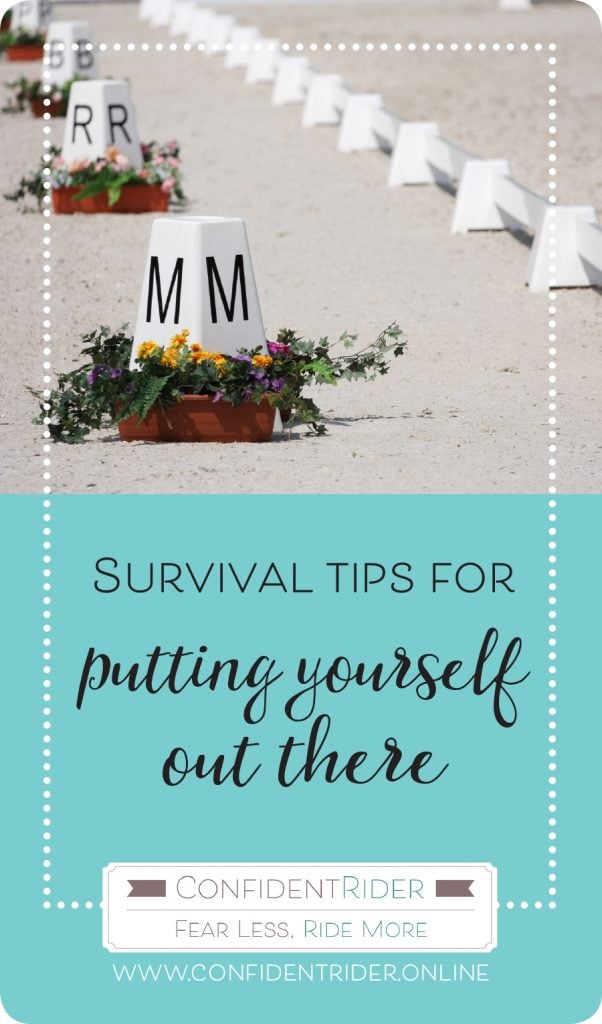
Survival Tips to Transcend the Moments When You are Going to Put Yourself out there and feel a little …. Stupid.
It’s a sad state of affairs when we limit ourselves and our capacity based on what other people are thinking. If you are hung up on the thoughts and opinions of others, or don’t put yourself out there at the risk of looking stupid, here are three of my top survival tips for setting that baggage aside and strutting your stuff like the equestrian version of Charlie’s Angels. Let’s hit it.
1. Remember your outcome
When we start feeling stupid and worrying about what everyone around us is doing, we forget why we are doing it in the first place. It distracts us from Mission: Awesome and instead turns it into Mission: Hot Mess. Know what you are doing there, why you are doing what you are doing and how it fits into your overall plan and future goals.
Anyone who achieved great things spent some time feeling like they didn’t know everything, like they couldn’t yet do what they wanted to do in the way that they wanted to do it, and yes, feeling a bit stupid. When you start to stretch the bubble of your comfort zone you are quite literally expanding your comfort zone. And when you start to expand your comfort zone, guess what? You feel uncomfortable! If you don’t feel uncomfortable, well… you are still inside your comfort zone.
Uncomfortable is ok. Your comfort zone will expand to meet you in time. But if you don’t move the perimeter posts, it’s never going to happen.
2. Remember, it’s temporary.
We need to reframe this for a second. You are far from stupid right now. What you actually are is a Neural Highway Ninja. Basically, all those neural networks in your body are connecting up new pathways, joining the dots together and building both your mental and physical muscles in ways that will allow you to get out there and repeat the same task much more ease-fully in the future. You getting out there and actually doing it- not thinking about it, talking about it, or drinking coffee about it- is the only way that you are going to make this happen. The only way.
Forget stupid. Your totally bad ass. B.A.D. A.S.S.
You heard me!
3. Work out your Inner Circle of Awesome.
In all likelihood, most people aren’t as obsessed with us as we are. Strange I know. If, however, you just can’t get past wondering what other people are thinking, then you need to get selective. Narrow it down.
In the Academy, I talk about the Inner Circle of Awesome. Your Inner Circle of Awesome is your crew, your posse, the group of people that know you, know your horse and know where it is that you are both heading. These are people who have your best interests at heart and whose opinion you can listen to. From their constructive feedback, you can pick out the jewels that will help you further your training and continue on.
Everyone not in your circle of awesome you can absolutely listen to, but they are essentially surplus to requirements. Appraise any feedback on its value mechanism. Can I use this information to improve the performance of me or my horse?
If yes, fabulous. Thank you and move on.
If not, fabulous. Thank you and move on.
Be clear on what you want, and take immediate steps towards actualizing it. If you are going to shine like a crazy diamond, you can’t hide under all the rocks in the pond. Get out there and do it! I’ve got your back.
xx Jane
Mental Training for Competition
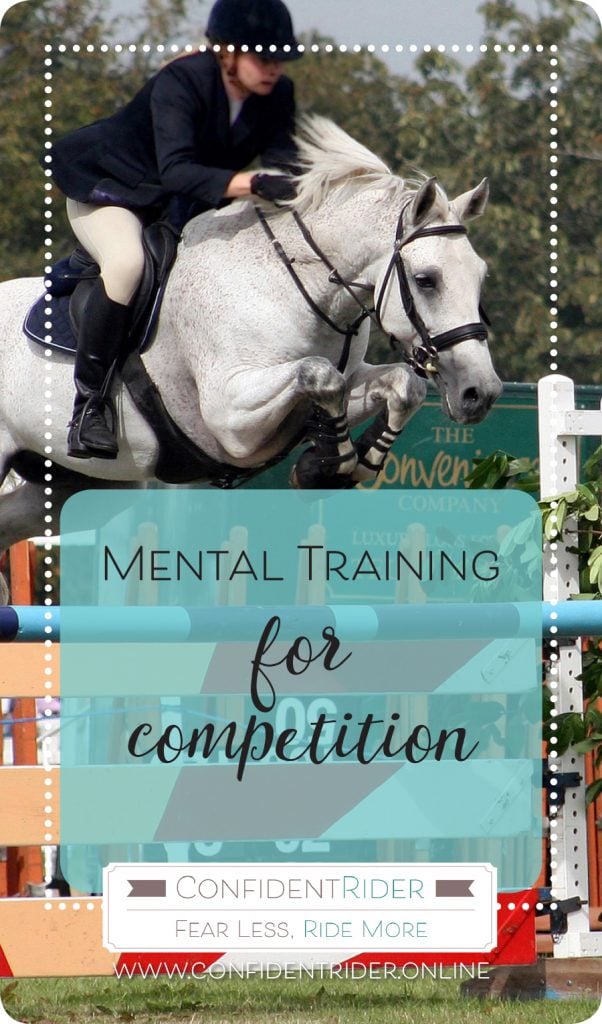
Last week, someone asked me about the approach I take training riders for high-level competition. For many, the thought of it comes as a shock. Wouldn’t someone competing at the elite level of his or her sport already have it together? What would they need with a coach like me?
Well, it turns out, quite a lot! Mental training techniques are not all about overcoming fear, working with confidence issues or taming anxiety. They are primarily about optimization- how we can optimize and train our minds to deal effectively with the pressures and stresses that arise in the competition arena.
My chief aim when working with someone who is interested in bettering their performance is to allow them to fine tune the existing skills that they have and produce their desirable outcomes on a more consistent basis than they would be able to previously
I am not their riding coach.
I am not their dressage or jumping instructor.
I am their mental coach and I am there to give them the skills to build the muscles of their mind in the same way a personal trainer would be on hand with a program to build strength and endurance in the body.
If you want to get physically stronger; if you want to improve your jumping technique; if you want to get better dressage scores then you hire a trainer who can give you proven methods and skills to enhance your own skill set and performance. Hiring a mind coach is no different; I help people identify the processes that bring them results and give them the skills that increase their mental fortitude and enhance the mind’s ability to focus.
One of the big fallacies is that professional riders don’t feel nervous. Nothing could be further from the truth! Many of the elite riders that I work with DO feel nervous, and it’s often inevitable. Pre-competition jitters can enhance performance by sharpening our sensory systems, but they can impair our performance when we can’t adequately control them. This is where the ability to be able to deal with pressure becomes so important.
There are several elements that I attend to when putting together a program for competitive athletes, and each are specified and tailored to the individual concerned. All combine to form a formula that can be worked through on a daily basis.
The first is breath work. From a physiological point of view, as soon as we experience pressure, we experience an acceleration of our heart rate. Controlled and specific use of the breath gives us primary control over our “arousal state”, which is the level of energy that an athlete experiences prior to and during performance. Across the board, we are looking to keep our heart rate below 120 beats per minute. Without adequate mental preparation, anyone whose heart rate exceeds 120 beats per minute will experience significant loss of mental focus and “sharpness”; over 150 beats per minute and we switch over to survival mode. As a consequence, controlling our heart rate with our breath becomes more than significant.
I will summarise briefly the other elements that are attended to:
1. Specific mental programming techniques in relation to our internal dialogue on the field, or our self-talk: This helps to continually direct our focus and avoid unhelpful internalizations of doubt and negativity.
2. Visualisation: Repetition of specific past and future outcomes and projections using proven and researched visualisation methods
3. Beliefs and Identity: Our self image is the key agent of our behavior, bringing forward the thoughts, actions and behaviours needed to fulfill our ideals and expectations.
4. Anchoring: Connecting specific stimuli with specific emotional states.
When the right ingredients are combined, what you are left with is a highly effective and easily implemented mental training workout. It’s the practical means to develop tangible results that are reflected in performance.
xx Jane

